Magnolia trees are a true mark that spring is here. Along with some of the early bulbs, they emerge early in the spring when we’re just coming out of winter’s clutches. If you are a new magnolia parent (or interested in becoming one), here is everything you need to know about growing the magnificent and alluring magnolia tree.
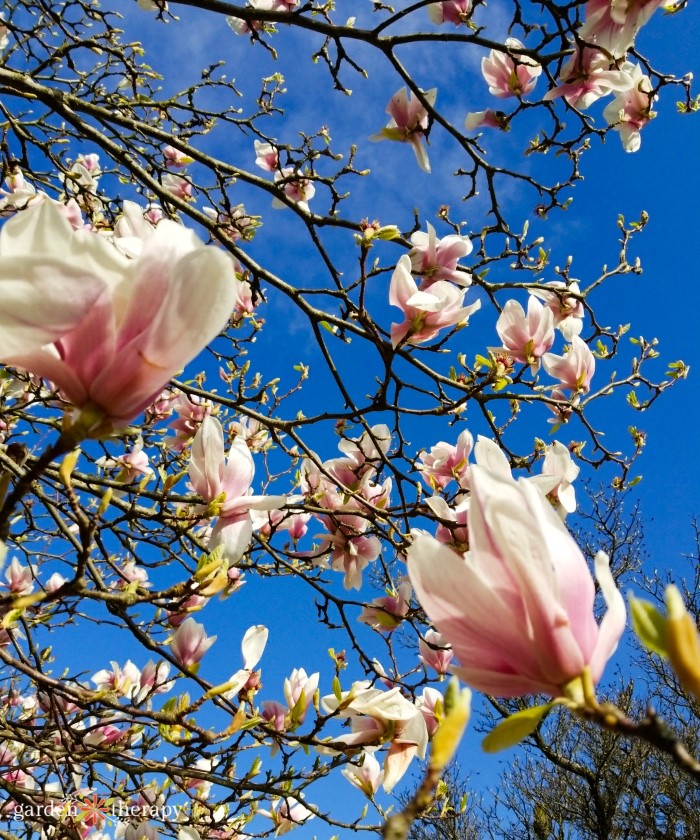
Spring in Vancouver is a beautiful time of the year thanks to the cherry blossoms and the magnolia trees. In April, I’m lucky enough to be graced with magnolia flowers in my garden. I have a saucer magnolia with pink flowers that burst before the leaves come out.
Underneath the tree, a collection of pink petals pile up. Then, the leaves will come out and I know that the warm weather is here to stay. I even get a new round of flower buds in a dark, fuchsia purple. But these ones never open! Instead, they fall to the ground. I enjoy them still nonetheless.
Over the years, I’ve used all parts of the magnolia tree. I use their unique leaves to create beautiful and long-lasting fresh wreaths. Their seed pods work as natural decorations. And their fresh petals can even be enjoyed by the tastebuds as edible flowers!
If you have a magnolia tree or want to add one to your landscape this season, here are the wonders of the beautiful plant.
This post will cover….
- Meet the Magnolia Tree
- Types of Magnolia Trees
- Southern Magnolia Tree
- Saucer Magnolia
- Anise magnolia
- Star Magnolia
- Edible Uses
- How to Grow a Magnolia Tree
- Frequently Asked Questions About Growing a Magnolia Tree
- More Posts About Trees
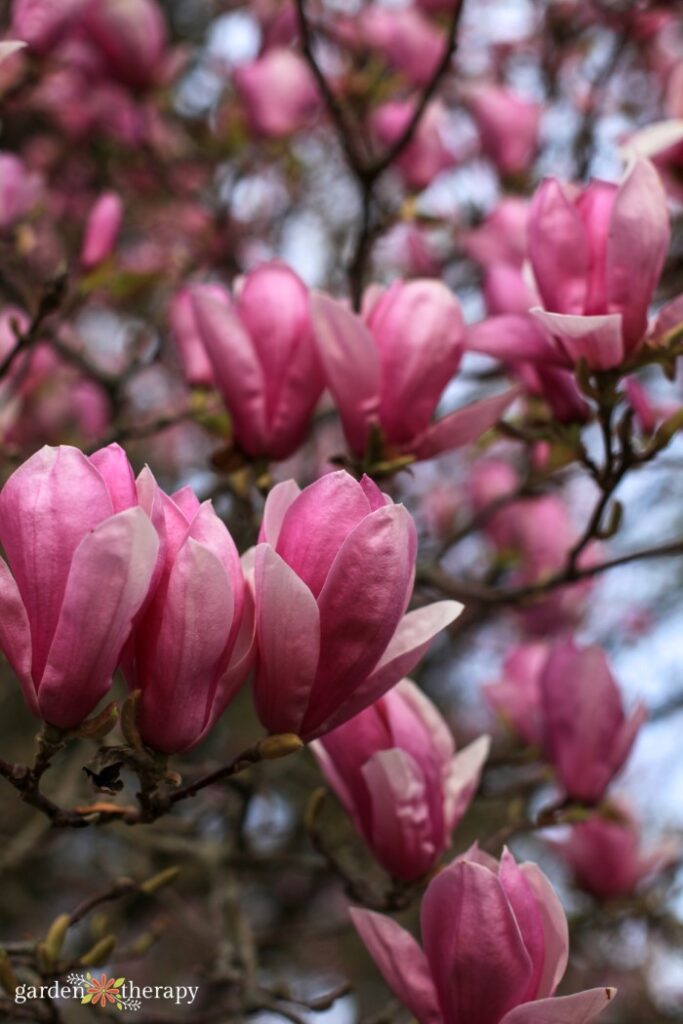
Meet the Magnolia Tree
Magnolia flowers are well known for their alluring fragrance and large flowers. They come in various shades and mixes of white and pink, though you can also find them in purple and yellow. A very popular ornamental, they can be formed into espaliers, shrubs, or tree forms.
One of the things I like best about the magnolia is its unique leaves. Some of the magnolia leaves have an indumentum. This is a layer of trichomes which are hairy-looking tiny bristles that cover an area of the plant. On one side of the leaves is a dark glossy green and on the other, a hairy copper colour.

Considered a primitive plant, magnolia trees existed over 100 million years ago. Fossilized leaves have been found in Europe, North America, and Asia. Today, the plants are only native to southern China and the southern US. There are around 80 species of magnolia trees.
The sweet magnolia tree from America was the first brought to Europe. In China, the plant was cultivated as early as the 7th century. The Aztecs also grew magnolia trees for their beauty.
Magnolia trees are unique in that they are pollinated by primitive wingless beetles. They have no nectar and an abundance of pollen, existing long before winged insects like bees came around. This is also why they bloom in early spring before many insects have appeared. It’s also why most species don’t often set seeds.
Those that do get pollinated, however, produce a dangling fruit. I also love using their dried seed heads for decoration, like in this air plant wreath.

Types of Magnolia Trees
As a general rule of thumb, magnolia trees can turn into quite big trees. Many advertise them as smaller-sized trees, but they’re still too big for small gardens. However, you may be able to locate some dwarf magnolia tree varieties of these popular species below.
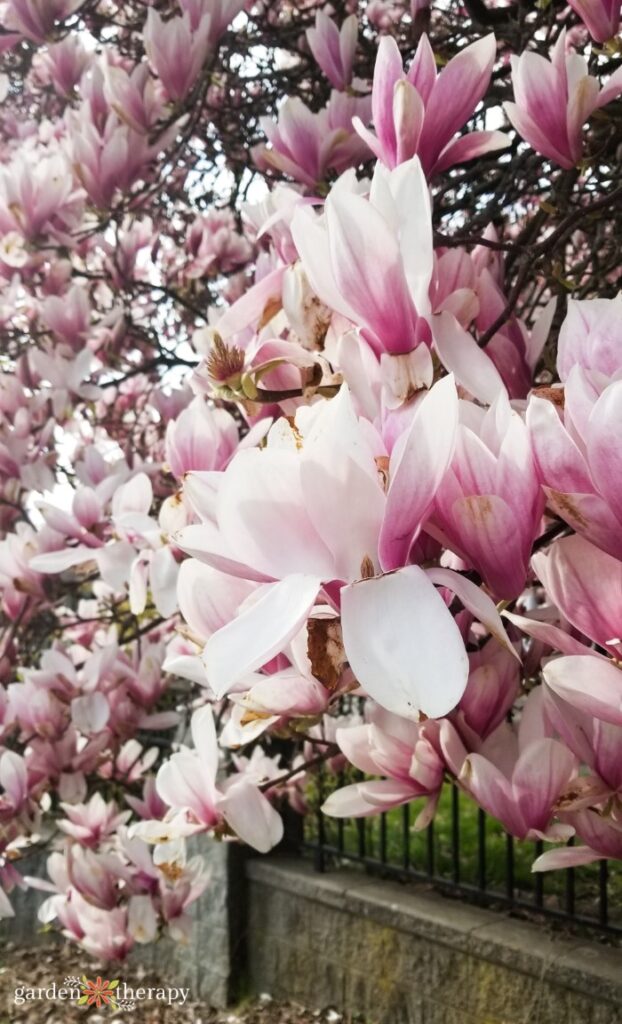
Southern Magnolia Tree
Magnolia grandiflora
Native to the southeastern united states, southern magnolias are the most common type of evergreen magnolia. The white blooms are very large and fragrant. The leaves last a long time, with the popular indumentum mentioned above. The leaves are a stand-out dark green on top and copper underneath.
Southern magnolias can reach up to 100 ft tall though there are many smaller cultivars available (such as the ‘Little Gem’ magnolia tree pictured below). They grow in zones 7 to 10.
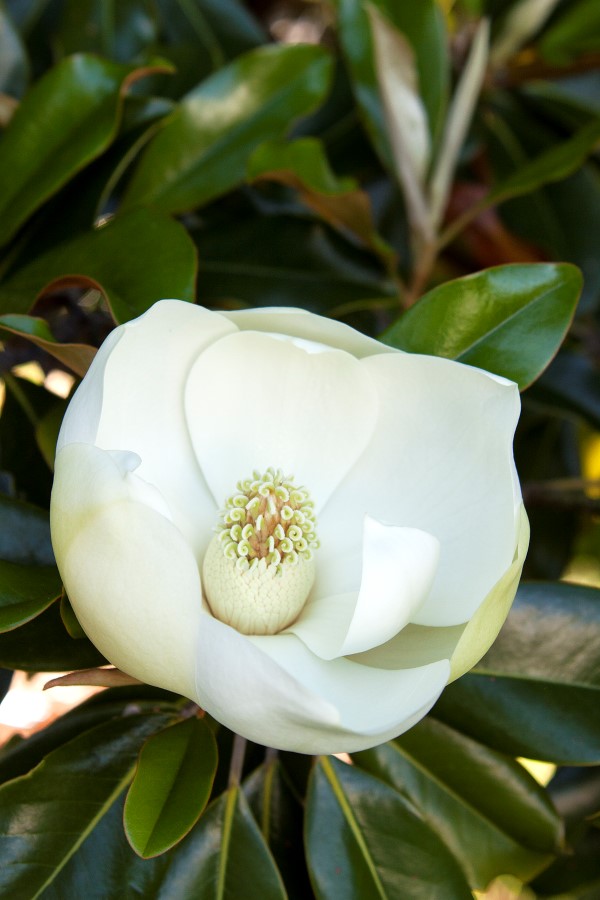
Saucer Magnolia
Magnolia x soulangeana
A hybrid magnolia, the saucer magnolia is a deciduous magnolia made by cross-breeding the lily magnolia with the lily tree. Some gardeners also refer to it as the tulip magnolia tree or simply a tulip tree.
The flowers bloom very early, appearing before the leaves. They form cup-like shapes and can be enjoyed as edible flowers. Native species are pinkish white but you can also find them in bright pink and purple. Sometimes, you can also get a second round of blooms though they’re smaller and may not fully open.
The saucer magnolia can be grown as a flowering tree or shrub, reaching up to 40 ft tall and wide. They grow in zones 5 to 9.
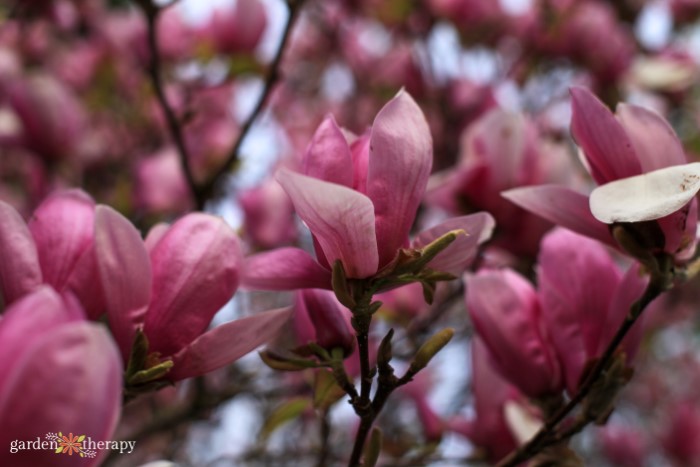
Anise magnolia
Magnolia salicifolia
One of the smaller magnolia trees, the anise magnolia blooms in early spring before the leaves arrive. It has white flowers with a hint of pink and thinner leaves than most magnolias.
It’s particularly known for its specific anise-lemon scent found in the flowers as well as when you scratch off the bark.
Anise magnolia trees grow 20 to 30 feet tall and wide and grow in zones 4 to 9.
Star Magnolia
Magnolia stellata
This one is all in the name! People recognize this deciduous magnolia most for its star-shaped white flowers. It blooms in early spring, typically around March or April. It has fuzzy buds and a mild fragrance.
This is the best variety for smaller gardens. It may even grow in a container before it reaches maturity. They grow up to 15 ft tall and wide. Star magnolias grow best in zones 3 to 10.
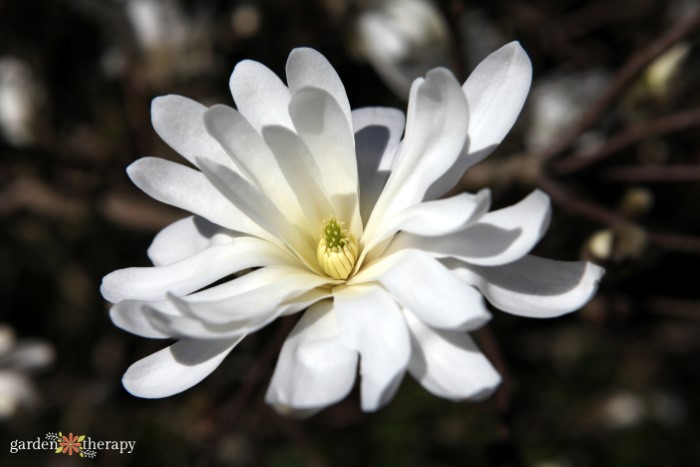
Edible Uses
As I hinted above, you can actually eat magnolia flowers. Not all magnolia flowers are tasty, so make sure to fully identify them before eating. For instance, you don’t want to feast on the magnolia stellata.
The most popular magnolia for eating is the saucer magnolia, Magnolia x soulangeana. Best eaten when they’re still buds, they taste very gingery but can also lean towards the bitter side. So, take a nibble before you commit! The darker pinks and mixture of pink/white flowers will have the strongest flavours.
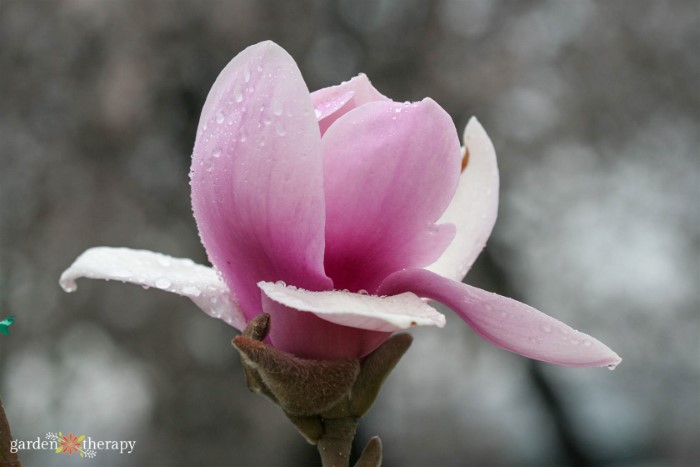
Treat the flower like a condiment or spice. The edible parts include the petals and the magnolia ‘pineapples’ which are the center of the flower. You can use them to steep a tea or dried up as a spice for a little zest and ginger replacement. You can also pickle the flowers. While they don’t preserve their colour, the flavour will taste like pickled ginger.
You can learn more about edible flowers in this post.
Alexis Nikole, or ‘Black Forager’ on Instagram and TikTok, uses magnolia flowers to make her own version of ginger snaps…magnolia snap cookies! She makes a magnolia syrup to get the spicy flavour from the flowers. If you’re feeling brave, give it a try yourself.
How to Grow a Magnolia Tree
As you know, there are many different magnolia tree varieties. So you want to make sure to follow the growing and planting instructions for your specific magnolia. Look to the plant tag for care instructions and identification. But here are some general tips for growing a magnolia tree.
When selecting a location, plant your magnolia in full sun. They need at least six hours of sun per day to thrive. As early bloomers, sometimes frost can damage the flowers. To avoid this, don’t plant a magnolia tree in shady or frosty areas.
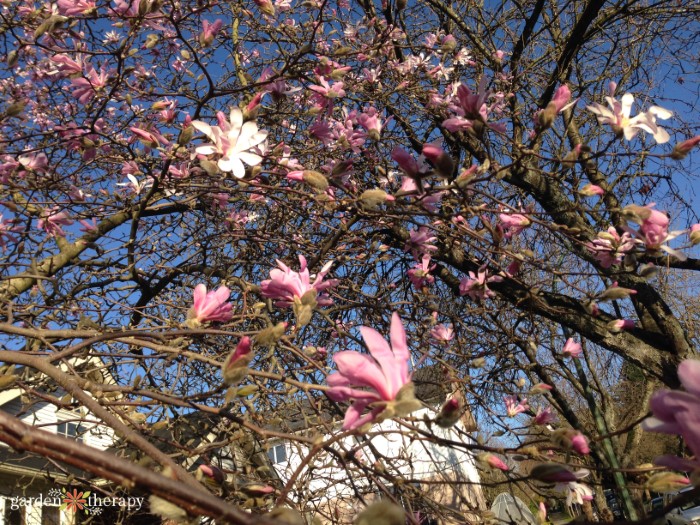
Choose a location with well-draining soil as they don’t like having wet feet. They prefer neutral to slightly acidic soil (check your soil with this easy at-home pH test). Water your magnolia when it’s first getting established and during any periods of intense drought.
In terms of maintenance, there isn’t much you need to do for the magnolia. No fertilizer is necessary and they’re typically pest and disease-free.
For pruning, you only need to trim back broken branches or those for shaping purposes. Prune in mid-summer to early autumn (after flowering and before dormancy).
Smaller magnolias may also grow in pots. In this case, give them good drainage and plant in high-quality potting soil. They also need some shelter from the wind.

Frequently Asked Questions About Growing a Magnolia Tree
Most magnolia trees bloom in early spring, even before their leaves have unfurled. They’re some of the first bloomers of the spring, typically blooming from March to April.
You may even get a second round of blooms into the summer, though this is rare. To achieve this, your magnolia needs ideal growing conditions. It’s most common with saucer magnolia trees.
A magnolia tree’s growth rate will vary depending on the species. Typically, they have a moderate growth rate. Magnolias will reach maturity in 10 to 20 years. As they get closer to their full maturity, their growth rate will slow down.
Deciduous magnolia trees are best planted while they’re dormant in late fall or early winter if you live in a warmer climate. In cold climates, early spring is best. Evergreen magnolias should be planted in early spring.
However, whenever your garden centre has them for sale is an okay time to plant them. As long as the ground is workable and you water them until they’re well-established, they should do just fine.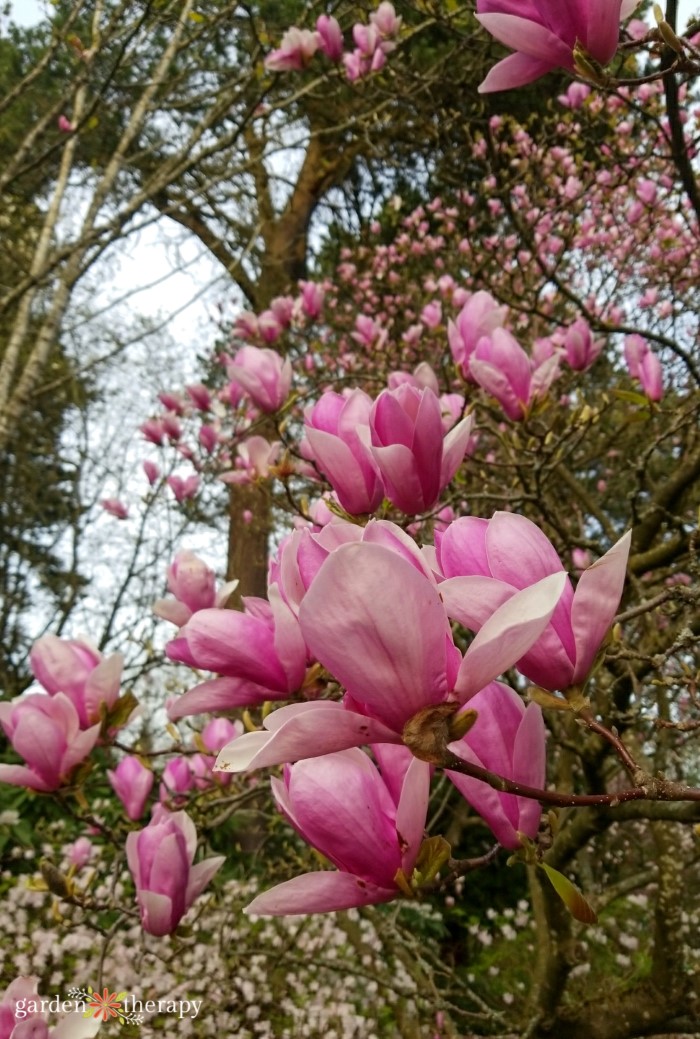
Magnolia trees typically don’t require much pruning. Only trim a magnolia tree if it has a diseased or broken branch, or you want to shape it.
Magnolia trees bloom on old wood so you want to be careful with pruning. Trim in mid-summer to early fall for shaping since the tree blooms in early spring. If the plant is diseased or broken, prune at any time.
Plants turn yellow for many reasons, oftentimes it’s a sign of distress. However, if it’s a deciduous magnolia, consider if it’s a seasonal change. Like all deciduous trees, the leaves will change colour and shed in the fall. If there’s a sudden drop in temperature, this could be earlier than normal.
Other causes for yellowing leaves could arise from lack of water during a serious drought or not enough drainage in the soil.
You can also consider testing your soil’s pH and see if there is a nutrient deficiency. Also examine the branches, trunk, and leaves, for any signs of diseases or pests.
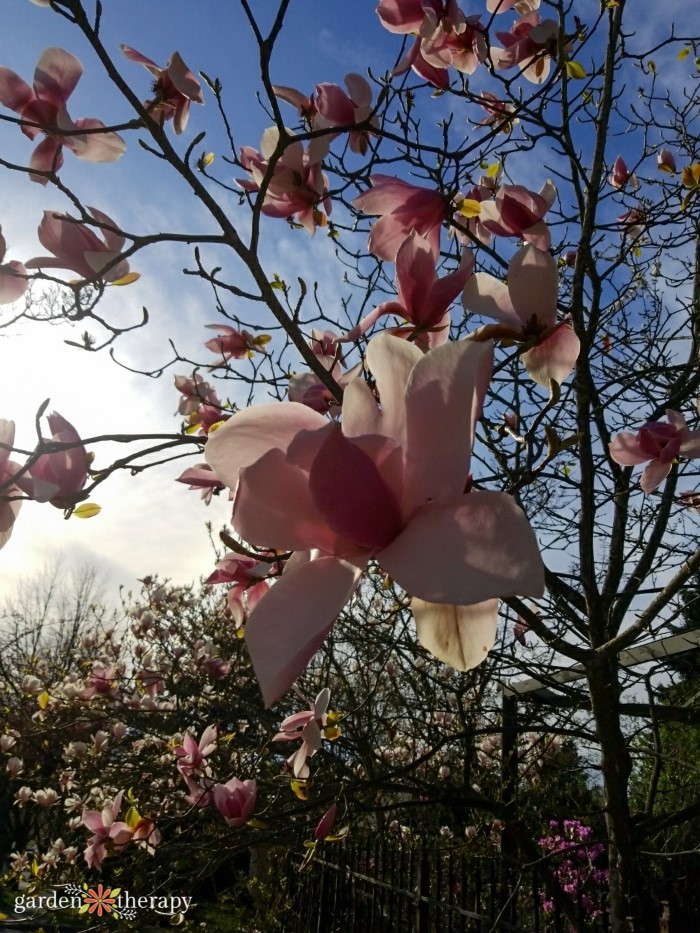
Magnolia trees truly are one of spring’s greatest pleasures. If you live in a magnolia-friendly area, I highly suggest you plant one in your own yard to enjoy. Let me know any of your further magnolia questions down below!

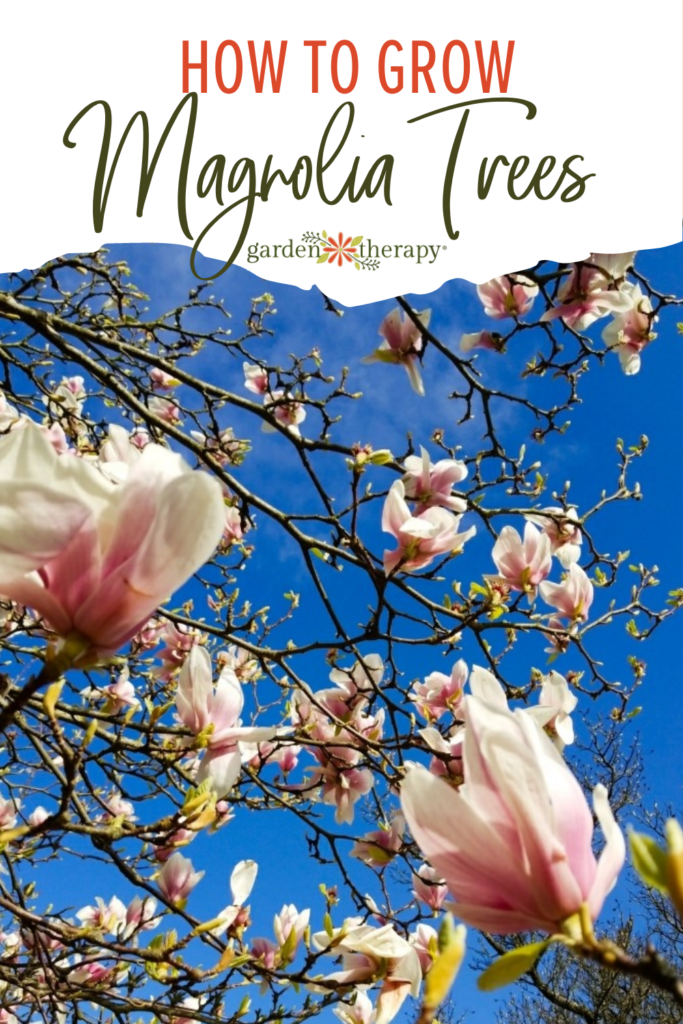



We inherited a beautiful elderly magnolia tree some 20 years ago when we bought this 1890’s house here in Milwaukee. We’re not sure how old this tree is but It is a conversation piece for the neighborhood as it suddenly pops out in full bloom overnight. Thank you for the info on these beautiful trees. Our other elderly plant that attracts attention and phone/picture taking by walkers is a poppy plant. Several people in the neighborhood have asked and been granted seeds from it so I hope its offspring are blooming all over our neighborhood. And p.s. speaking of age, I am 91 and have a wonderful veggie garden in my small city yard. So fun to pick and eat a tomato warm from the sun.. and to offer one to a small neighbor as she/he walk by with parents. (Some children don’t know that their food actually grows in dirt.
I live in Central Florida zone 9b. I planted 2 little gem magnolia trees April 2021 in my front yard. One is doing well and this spring has flowered so beautifully. The other not so well. It looks sparse compared to the other one. But it did flower this year too. I was wondering if cow manure can be put around the base of the tree. Or what kind of fertilizer can be used. Also one has some kind of white powder looking substance on its branches. Is this harmful to the tree? Lastly how often should I water my trees? My husband thinks the trees needs water every other day but I said twice a week since we have very little rain. Thanks for your help.
I am about to move my magnolia is 33yrs old hoe do I take a cutting as my mum and dad bought it for me
How big is it?
My magnolia was 5 when it was struck by a vehicle ,, then at age 7, was hit again. The first put a massive scar on one side, the 2nd hit was on the other side and not too severe. It was slated for destruction and I begged the guy in the front loader to bring it to my house. He reluctantly agreed. He damaged roots and the tree got another beating b4 we lovingly put it in its new home. This will be our 3rd year. It shot up suckers which I was advised to cut off, so I did. Do you think it will survive?
wow! What a story. My goodness. It’s hard to say, but she sounds like a survivor!